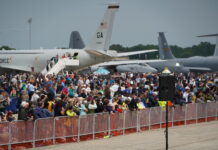The first several weeks of 2014 have been an interesting time here at ICAS headquarters. As our industry steps up its planning for the upcoming air show season, ICAS members are making adjustments that reflect the difficulties our business faced in 2013. Beyond the practical questions and comments, I’ve had many conversations and email exchanges about the long-term implications of last year’s sequestration-related troubles, the future of our industry, and how 2013 should or should not impact 2014, 2015 and beyond.
To help quantify and prioritize the membership’s perspectives on these issues, ICAS recently developed a survey that will be used by the Board to help develop a five-year strategic plan for ICAS. Survey results are just starting to come in and will be reviewed in a future issue of Air Shows Magazine, but the development of the survey questions was an enlightening exercise all by itself.
We posed a couple of questions about large, general topics. We asked respondents to prioritize the challenges facing the business. Is reducing the regulatory burden in our business more important than restoring military participation? Is it more important to strengthen existing shows or create new ones? Would the industry be better served by working to reduce expenses or increase revenue? Where does the challenge of reducing the accident rate stack up in relative priority to increasing sponsorship or increasing our advocacy efforts with legislators and regulators? Implicit in those survey questions are larger, almost existential questions about the air show business. What is the air show community and what are its most imminent threats and challenges?
But the survey is not the only place where these issues are being discussed; they’ve been the topic of conversations and exchanges throughout the 2013-2014 “off season.” It’s my sense that, collectively, the industry knows that it has reached a watershed moment in the evolution of the business. There’s a clear understanding that, for most ICAS members, events of the last two years have fundamentally changed the business. And there’s a strong desire to get out ahead on these issues…to anticipate the likely long-term impact and make changes now that will better position air show businesses to survive and thrive.
Is there a new model – or even multiple models — that will work in this new environment? If the military’s participation in air shows will be less reliable, does it make sense for our industry to plan air shows that don’t necessarily require the military’s participation to be successful? Does it change an event organizer’s approach to developing a line-up of civilian performers? How might the marketing and promotion for a “military-less” show differ from the marketing and promotion for shows that included the military? What kind of additional pressure does this put on civilian performers to be even more polished, even more entertaining? Big questions with huge implications to the future of the business.
The $64,000 question, of course, is, “Who has the best crystal ball?” Whose assessment of how 2013 has changed our business is most accurate? And what, if anything, do those assessments tell us about steps that should be taken to either take advantage of or – at least – minimize the negative impact of those changes?
Perhaps the most serious threat is that some in our business will simply ignore the mounting evidence that things have changed. The urge to return to “business as usual” as soon as possible is tempting. And, of course, there are segments of the industry that make little or no use of military assets. For them, very little has changed. But – for most – the reduction in military participation represents the single most significant change to the dynamics in our business in more than a generation.
During the last 50 years or so, largely as the result of a speech that John F. Kennedy made in 1959, hundreds of motivational speakers have built their presentations around the premise that the Chinese symbol for “crisis” is a combination of the symbols for “danger” and “opportunity.” As it turns out, this isn’t entirely true. There seems to be no argument that the first symbol means “danger.” But the second symbol has many meanings, depending on the context in which it is used: pivotal moment, crucial point, chance, airplane (yes, AIRPLANE!), suitable occasion AND opportunity. And, though this more nuanced and complicated definition does not lend itself as well to after-dinner speeches, it defines even more accurately the circumstances that the North American air show community finds itself in. A potential crisis that may certainly be dangerous, but which is also a pivotal moment in the evolution of the industry and an opportunity for some.







